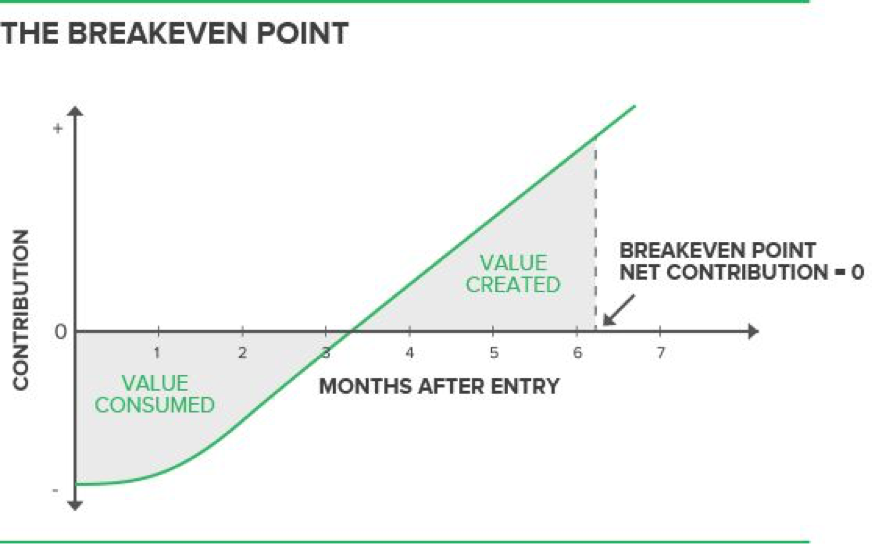The First 90 Days as a UX Designer
A practical guide for UX Designers on navigating the first 90 days. Learn how to onboard strategically and deliver early wins.

Landed a job, now what?
Starting a new job is exciting, but it also comes with anxiety and uncertainty. You want to do well, make a good impression, and prove you deserve the role. But with so much to learn and so many unknowns, it’s easy to feel lost.
In this article, I’ll share what I’ve learned from navigating my own first 90 days, so you can approach your new role with more confidence and clarity.
The first 90 days
Your goal in the first 90 days is simple: reach the break-even point as quickly as possible and pass your probation.
In his book The First 90 Days, Michael Watkins defines the break-even point as the moment when you’ve contributed as much value to your new organization as you’ve consumed from it.

To put it plainly, when we first join a company, we’re not immediately able to make an impact. We lack context, certain skills, and an understanding of how things work. The goal is to shorten that gap and reach a point where you can contribute meaningfully.
Common Challenges
From my experience, the first few months can be tricky. Common challenges include:
- Information overload that leads to paralysis.
- Overpromising — trying to prove yourself by taking on too much too soon, which results in stress, poor decisions, and underdelivering.
- As a result, falling into a vicious loop: slow learning → bad decisions → low trust from managers and peers.
This loop is painful, but preventable, and that’s where a 90-day plan comes in.
90-day plan
A 90-day plan is a structured roadmap that helps you learn faster and start creating value earlier.
It gives you:
- Structure: Helps you compartmentalize and prioritize what to focus on, reducing information overload and decision paralysis.
- Clarity: Helps you identify low-effort, high-impact opportunities for quick wins, so you can contribute meaningfully without overextending yourself.
- Alignment: Helps you align your goals and expectations with your manager, setting clear milestones for probation success.
Typically, a 90-day plan breaks down into a few milestones:
- 30D (Month 1): Accelerate learning and build relationships
- 60–90D (Month 2–3): Deep dive and secure quick wins
- >90D (Month 3+): Reflect, iterate, and move forward
30D (Month 1)
In the first 30 days, your goals are to:
- Accelerate learning
- Build relationships
- Set probation goals
Accelerate learning
To get up to speed, break your learning into different categories, take action proactively, and look for answers.
Business:
- What are the yearly and quarterly goals?
- What is the business strategy? How is success measured (KPI/OKR)?
- What is the business model? How do we make profit?
- Who are our competitors? What is our competitive advantage?
- Possible actions: Review town hall materials, create a business model canvas, conduct competitor and SWOT analyses.
Product:
- Who are our target users? What are their jobs-to-be-done, pain points, and goals?
- How do our product’s value propositions or features solve their problems?
- What are we building now and next? Why? How is product success measured?
- Possible actions: Create a value proposition canvas, review user research artefacts (e.g., personas, journey maps), study the product roadmap and metrics framework.
Process:
- What is the product development process (e.g., sprint cycle or project-based)?
- Who are the stakeholders at each stage? Who signs off?
- What artefacts are expected at each step?
- How are documentation and design handovers done?
- What are the brand, design system, and content guidelines?
- Possible actions: Observe sessions (e.g., sprint planning, design critique), create a stakeholder map, review documentation (brand guide, design system, content guide).
Build relationships
“If you want to go fast, go alone. If you want to go far, go together.” — African proverb.
Success depends on collaboration, so build rapport and relationships with your peers. You can do this based on your style, for example, schedule 1:1s (formal) or have casual lunches (informal). Use these interactions to learn and gather information under Accelerate Learning as well.
Set probation goals
In the first week, schedule a session to understand your manager’s expectations and set probation goals. This step is crucial, I’ve heard stories where newcomers and managers had mismatched expectations, resulting in frustration and unclear direction.
Clear communication ensures both sides understand the goals, success measures, and actions needed. Once aligned, update your 90D plan and adjust accordingly.
Tip: Depending on your manager’s style, you may or may not need to show your plan. Treat it as your personal guide.
60–90D (Month 2–3)
These 2 months are often fluid; experiences vary depending on your role and probation goals.
Generally, the focus areas are:
- Secure small wins
- Build cross-team connections
Secure small wins
As you gain more context, you’ll start spotting areas for quick wins — small improvements that create visible value.
Spot high user drop-off areas in a feature? Do a heuristic analysis, address gaps, and measure results; Identify inefficiencies in design processes? Recommend improvements.
Build cross-team connections
As you start working across functions, it’s important to build relationships beyond your immediate team.
Connect with people from different departments — customer service, engineering, marketing, compliance. Having a contact point in each team makes collaboration much smoother when you need domain expertise.
>90D (Month 3 beyond)
Once you hit the 90-day mark, take a step back and reflect. Have a 1:1 with your manager to get feedback and discuss next steps. Ask your peers for feedback, they often see things you don’t.
Reflect on what worked, what didn’t, and how you can refine your approach going forward.
Summary
- Your goal in the first 90 days is to reach the break-even point.
- A 90-day plan gives you structure, clarity, and alignment.
- The first 30 days: learn fast and build relationships.
- The next 60–90 days: secure small wins and build cross-team connections.
- After probation: get feedback, refine your approach, and plan the next phase with your manager.
Having a plan won’t make the journey perfect, but it gives you a compass when everything feels new and uncertain. And that makes all the difference!
Further Reading
- https://uxplaybook.org/articles/a-guide-to-your-first-90-days-in-a-new-ux-role
- https://uxdesign.cc/a-30-60-90-day-plan-for-product-designers-f475aad13815?source=login————————–global_nav——————&gi=2a7d15a4988b
- https://www.youtube.com/watch?v=Y6_x3seuCAc
- https://www.youtube.com/watch?v=KcTI98JWLwE
The First 90 Days as a Product or UX Designer was originally published in UX Planet on Medium, where people are continuing the conversation by highlighting and responding to this story.